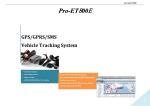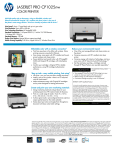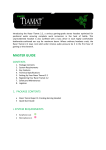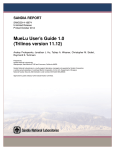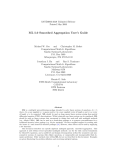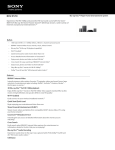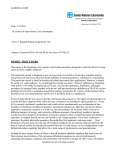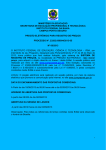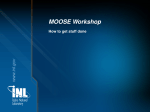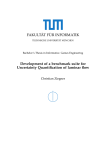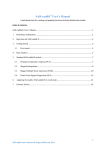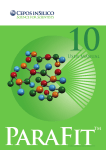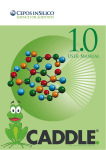Download VERA 3.3 Release Notes
Transcript
CASL-U-2015-0042-000 VERA 3.3 Release Notes April 20, 2015 Protected under CASL Multi-Party NDA No. 793IP 1 VERA 3.3 Release Notes REVISION LOG Revision Date 0 Affected Pages All Revision Description Initial Release Document pages that are: Export Controlled _____None_____________________________________________ IP/Proprietary/NDA Controlled____None_____________________________________________ Sensitive Controlled____None________________________________________________ Requested Distribution: To: Copy: Consortium for Advanced Simulation of LWRs ii CASL-U-2015-0042-000 VERA 3.3 Release Notes 1. GENERAL REMARKS The CASL software components provided in this release are under active development, and are subject to change. They have not been fully validated or assessed, and should be used primarily for test, evaluation, and research purposes only. The Virtual Environment for Reactor Applications components included in this distribution include selected computational tools and supporting infrastructure that solve neutronics, thermal-hydraulics, fuel performance, and coupled neutronics-thermal hydraulics-fuel performance problems. The infrastructure components provide a simplified common user input capability and provide for the physics integration with data transfer and coupled-physics iterative solution algorithms. Neutronics analysis can be performed for 2D lattices, 2D core and 3D core problems for pressurized water reactor geometries that can be used to calculate criticality and fission rate distributions by pin for input fuel compositions. Two neutronics capabilities are provided in this distribution including MPACT (from the University of Michigan) that supports 2D lattices and Insilico (from Oak Ridge National Laboratory) that supports 2D lattices, 2D core planes, and 3D core geometries. Both codes include integrated cross section capabilities that provide problem-specific cross sections for the problems defined. A thermal-hydraulics capability is provided with CTF (an updated version of the COBRA-TF code developed by the Pennsylvania State University) that allows thermal-hydraulics analyses for single and multiple assemblies using the simplified VERA common input. This distribution also includes an initial coupled neutronics/thermal-hydraulics capability to allow calculations of single assemblies using Insilico or MPACT coupled with CTF. The VERA fuel rod performance subcomponent BISON-CASL calculates, on a 3D basis, fuel rod temperature, fuel rod internal pressure, free gas volume, clad integrity and fuel rod waterside diameter. These capabilities allow simulation of power cycling, fuel conditioning and deconditioning, high burnup performance, power uprate scoping studies, and accident performance. Specifically targeted at VERA’s core simulator functionality (VERA-CS), the existing VERA subchannel-neutronics capability based on CTF and Insilico has been extended to use the axisymmetric 2D R-Z fuel rod modeling functionality of BISON-CASL to produce a three-way coupled neutronics, thermal-hydraulics and fuel performance capability known as Tiamat. This distribution is intended to be used for testing and evaluation of the released components of VERA. Testing within CASL has focused specifically on Westinghouse four-loop reactor geometries and conditions with example problems included in the distribution. 2. SYSTEM REQUIREMENTS Linux platforms with functioning gcc, g++ and gfortran compilers and X11 libraries are supported. 32 cores or greater are recommended. Detailed system software and third party library requirements are specified in the provided VERA Installation Guide. CASL-U-2015-0042-000 1 Consortium for Advanced Simulation of LWRs VERA 3.3 Release Notes This distribution has been tested and verified to install and execute on the following OS distributions: • CentOS 6.6 • Ubuntu 14.04.1 • SUSE Linux Enterprise Server 11 SP3 • Fedora 21 • CrayOS Appendix A provides a summary of the compute resources required to execute each of the CASL Core Simulator Benchmark Progression Problems [1] 1-7 during acceptance testing on the EPRI Phoebe cluster. These resource measurements should be taken as a guide only – system configuration and resource variations can significantly impact the performance for other systems. 3. INSTALLATION Detailed installation instructions are provided in the VERA Installation Guide located in the distribution tarball under the VERA/doc/installation_guide folder and at www.casl.gov/docs/CASL-U-2015-0082-000.pdf. 4. DOCUMENTATION A detailed list of documentation provided with this release is given in Appendix B. Pointers to additional software documentation are provided in the README.<component> files found in the VERA/doc directory. Additional documentation, in the form of CASL technical reports and publications, is available at http://www.casl.gov/publications.shtml. 5. SUPPORT Questions, issues, bugs, and suggestions should be reported to [email protected]. Every effort will be made to respond to any requests within a reasonable period of time. Due to active development efforts users may experience some delays. 6. PHYSICS COMPONENTS INCLUDED IN VERA 3.3 6.1 MPACT MPACT 2.0.0 is based on the Method of Characteristics transport approach for 2D problems with cross section weighting based on the subgroup methodology [2]. The code can be executed in parallel to reduce overall run time. For 3D problems, MPACT uses the 2D/1D method which uses 2D MOC in a radial plane and diffusion or SPn in the axial direction. A 47 group library with subgroup parameters is provided. New features implemented since MPACT 1.0.0 are: • • Multi-State calculation capability Depletion and Decay o Direct coupling with ORIGEN o Alternative internal capability Consortium for Advanced Simulation of LWRs 2 CASL-U-2015-0042-000 VERA 3.3 Release Notes • • • • • • • • • • • • • • • • • Critical Boron Search Equilibrium Xenon Calculation Direct Coupling with COBRA-TF Simplifed Internal T/H Model Modeling of Control Rod Banks Fission Chamber Detector Response Separate B-10 Depletion of soluble Boron Semi-Explicit modeling of grid spacers Simulated Control Rod movement between states Checkpoint files Isotopic Restart Files Cycle-to-Cycle Fuel Shuffling Rotational Symmetry Improved Transport Corrected P0 Approximation 2-D/1-D Transport Capability NEM-Diffusion, SANM-Diffusion, SP1, SP3, and SP5 1-D Nodal Kernels 47-group Cross Section Library Data The following features are considered to be Stable. Footnotes refer to the Known Issues listed in Table 1 of Section 9 below. • • • • • • • • • • • • • • • • • • • Support for Windows OS (32-bit and 64-bit) Support for Linux OS (32-bit and 64-bit) Parallel Spatial Decomposition with MPI1 Parallel Angular Decomposition with MPI2 User defined Macroscopic Cross Sections 47-group Macroscopic Cross Section Library Data3 Transport Corrected P04 Export of Mesh to Legacy VTK file for visualization5,6 2-D MOC Transport Kernel7 Coarse Mesh Finite Difference (CMFD) Acceleration 1-D Nodal Kernels based on NEM-Diffusion and SPn8 2-D/1-D Full Core Solution7 Multi-State Calculation Capability9 Depletion and Decay10 Critical Boron Search Equilibrium Xenon Calculation Direct Coupling with COBRA-TF Simplified Internal T/H General PWR Geometry Modeling o IFBA11 o Control Rods and Control Rod Banks12 CASL-U-2015-0042-000 3 Consortium for Advanced Simulation of LWRs VERA 3.3 Release Notes • • o Burnable Poison Inserts o Fission Chamber Detectors o Grid spacers, Nozzles, Plenum, Baffle, etc. Checkpoint File Isotopic Restart File13,14,15,16,17 The following features are considered to be experimental, and are not mature: • • • • • • • Separate B-10 Depletion of soluble Boron Semi-Explicit modeling of grid spacers Rotational Symmetry (This feature should work without issue in most cases, but has not yet been extensively tested.) Cycle-to-Cycle Fuel Shuffling (This feature should work without issue in most cases, but has not yet been fully verified). o One known issue is that the assm_map in the input must match the shuffle_label card. o Shuffle by assembly serial number is not supported. o Changing the axial mesh is not supported for shuffle. 3-D MOC Kernels Processing of AMPX Working Cross Section Libraries 1-D Nodal Kernels based on SANM diffusion 6.2 Exnihilo Exnihilo is a modern radiation transport framework that implements a variety of advanced solvers and solution methodologies, enabling it to solve a wide variety of nuclear engineering and applications problems with the scalability to run on both desktop machines and leadership-class supercomputers. It supports “stand-alone” execution using its internal front ends, but its components (such as the Denovo ܵܰ solver) are also integrated into other radiation transport codes. The Exnihilo component Insilico is a 2D and 3D transport code based on the discrete ordinates (Sn) and simplified PN (SPN) methods to solve the transport equation. Both methods can be executed in parallel to reduce overall run times. Cross section processing is based on a unit cell approach using the XSProc capability from the SCALE code package and includes a 252 group cross section library. Exnihilo in VERA currently contains the following source code packages: • • Nemesis: Infrastructure components - This collection of utilities should be applicable to most scientific codes. Included are Design-by-Contract™ utilities, communication libraries, containers and algorithms, HDF5 and Silo interface wrappers, template-based serialization utilities, and the unit testing harness. Transcore: Tranport core components - These components are specific to radiation transport and multiphysics codes. Included are cross section storage classes, libraries for reading and writing cross sections, quadrature sets, Trilinos solver wrappers, Monte Carlo samplers, and Python interface wrappers. Consortium for Advanced Simulation of LWRs 4 CASL-U-2015-0042-000 VERA 3.3 Release Notes • • • • • Geometria: Geometry packages - The geometries in this class are used for meshing deterministic problems, for transporting Monte Carlo particles on, and for tallying. Geometries include mesh and cylindrical mesh, Reactor ToolKit geometry, MCNP geometry using the Lava wrapper, SCALE geometry, and DagMC geometry. Physica: Physics packages - These are geometry-agnostic physics engines used for Monte Carlo transport. Currently included are continuous-energy and multigroup physics packages. Denovo: Deterministic transport solvers - Denovo contains advanced transport solvers for fixed-source and eigenvalue problems, with discrete ordinates (ܵܰ) and simplified spherical harmonics (ܵܲܰ), using Cartesian grids with the KBA decomposition. Shift: Monte Carlo solver - The Shift Monte Carlo framework is based on geometry- and physics-agnostic transport routines. These routines include advanced parallel algorithms, flexible tallies, and extensible source definitions. Insilico: Neutronics front end - The Insilico front end couples Denovo and Shift with crosssection processing, depletion, and thermo-hydraulics feedback for reactor analysis. This component is integrated into VERA, the Virtual Environment of Reactor Applications. 6.3 CTF CTF (COBRA-TF) is a subchannel thermal-hydraulics code that uses a two-fluid, three-field (i.e. fluid film, fluid drops, and vapor) modeling approach. Both sub-channel and three-dimensional (3D) Cartesian forms of nine conservation equations are available for LWR modeling. CTF includes a wide range of thermal-hydraulic models important to LWR safety analysis including flow-regimedependent, two-phase wall heat transfer, inter-phase heat transfer and drag, droplet breakup, and quench-front tracking. Due to its 3D capabilities and extensive array of reactor thermal-hydraulic modeling capabilities, CTF has found much use in modeling of LWR rod-bundle transient analysis and Pressurized Water Reactor (PWR) whole-vessel, Loss-Of-Coolant Accident (LOCA) analysis. Stable features: • • Solid modeling capabilities o Radial conduction o Nuclear fuel rod models (pellet, gap, and clad regions and UO2 and zircalloy material properties) Fluid modeling capabilities o Solid-to-fluid heat transfer single-phase convection subcooled/saturated boiling o Critical heat flux (Departure from Nucleate Boiling) o Two-phase flow with droplets o Closure models Wall drag and form loss modeling Turbulent-mixing and void-drift Fluid equation of state o Incorporation of PETSc solvers o Variable size axial meshing CASL-U-2015-0042-000 5 Consortium for Advanced Simulation of LWRs VERA 3.3 Release Notes o Grid-heat-transfer enhancement modeling The following features are considered to be experimental or developmental, and are not mature: • • Solid modeling capabilities o Fuel rod axial/azimuthal conduction o Axial mesh refinement (quench front tracking) o Dynamic gap conductance model (pellet relocation and pellet-clad interaction) o Zircalloy-water thermal reaction o Fuel pellet cracking/sintering Fluid modeling capabilities o Non-condensable gas effects o Post-CHF heat transfer models (are encountered in validation tests, but no validation of models done) o Droplet entrainment/de-entrainment models (encountered in validation tests, but droplet field is not validated) o Channel splitting and coalescing o Channel flow area variations (rod ballooning) o Grid-directed cross-flow modeling o Boron-tracking model with consideration of boron precipitation 6.4 BISON-CASL VERA includes the capability to predict fuel rod performance utilizing 3-D, coupled multi-physics and represents a significant advancement for the modeling/analysis capabilities in LWR fuel rod behavior. The capability is being constructed within the MOOSE/BISON computational framework (from Idaho National Laboratory) that supports: • • • • • • Statics with elasticity, plasticity with strain hardening, creep, large strains, large displacements, and smeared plus explicit cracking; Unsteady (transient) heat transfer including conduction, convection and radiation with time and spatial (axially, radially and potentially azimuthally in a cylindrical fuel element) dependent internal heat generation; 2D axisymmetric, plane strain, and plane stress representations, including contact and friction interactions between pellets and between the pellet and cladding; 3D statics and dynamics with contact and friction, and heat transfer; Mixed dimensional coupling (via multipoint constraint equations, etc.), e.g., combined 2D and 3D numerical representations for coupled global (2D) and local effects (3D) modeling; and Utilizes high performance computing platforms to achieve the massively parallel performance and scalability required to perform coupled multi-physics simulations of full length 3D representations of the fuel rod components. Consortium for Advanced Simulation of LWRs 6 CASL-U-2015-0042-000 VERA 3.3 Release Notes The BISON-CASL fuel rod performance code architecture uses the finite element method for geometric representation and a Jacobian-free, Newton-Krylov (JFNK) scheme to solve systems of partial differential equations. The fuel rod performance capability includes models for: • • • • • • • • • • • • • • Clad stress, strain, and strain rate; Clad oxidation, hydrogen pickup and hydride formation; Pellet stress, strain, and strain rate; Fission gas release (transient and pseudo-steady-state); Pellet densification, swelling and fission product evolution; Pellet restructuring and high-burnup rim thickness; Pellet cracking and relocation; Thermal expansion, including pellet hour-glassing; Thermal and irradiation creep; Thermal conductivity effects due to clad oxidation and fuel microstructure evolution; Material strength and ductility effects due to irradiation, thermal cycling, hydriding, fission product evolution; Pellet-cladding gap evolution and local stress due to partial contact; Pellet stack growth and fuel rod growth; Explicit modeling of duplex and triplex clad designs; The VERA fuel rod performance subcomponent calculates, on a 3D basis, fuel rod temperature, fuel rod internal pressure, free gas volume, clad integrity and fuel rod waterside diameter. These capabilities allow simulation of power cycling, fuel conditioning and deconditioning, high burnup performance, power uprate scoping studies, and accident performance. It is important to note that these tools are built around the known performance of existing zirconiumbased clad with UO2 fuel and predictions for other fuel types may not be accurate. Estimates for the global effects of minor modifications to the fuel or clad may be possible; for example, chromiadoped pellets may be simulated with user-supplied models for several of the pellet performance characteristics or steel-based clad may be simulated with similar user-supplied models. Materials such as silicon carbides that do not fit the system paradigm can be simulated but are likely to provide inaccurate results. 6.5 Dakota The Dakota package (http://dakota.sandia.gov) manages and analyzes ensembles of simulations to provide broader and deeper perspective for analysts and decision makers. In its simplest mode, Dakota can automate typical parameter variation studies through a generic interface to a physicsbased computational model. This can lend efficiency and rigor to manual parameter perturbation studies already being conducted by analysts. Dakota also delivers advanced parametric analysis techniques enabling design exploration, optimization, model calibration, risk analysis, and quantification of margins and uncertainty with such models. It directly supports verification and validation activities. Dakota algorithms enrich complex science and engineering models, enabling an analyst to answer crucial questions of: • Sensitivity: Which are the most important input factors or parameters entering the simulation, and how do they influence key outputs? CASL-U-2015-0042-000 7 Consortium for Advanced Simulation of LWRs VERA 3.3 Release Notes • Uncertainty: What is the uncertainty or variability in simulation output, given uncertainties in input parameters? How safe, reliable, robust, or variable is my system? (Quantification of margins and uncertainty, QMU) • Optimization: What parameter values yield the best performing design or operating conditions, given constraints? Calibration: What models and/or parameters best match experimental data? • A CASL Technical Report providing user guidelines and best practices for CASL VUQ analysis using Dakota (CASL-U-2014-0038/SANDIA Report SAND2014-2864) is available at: https://dakota.sandia.gov//sites/default/files/documents/SAND-CaslDakotaManual.pdf The following features are considered to be mature and robust: • • • • • • Parameter studies: list, vector, centered, multi-dimensional Uncertainty quantification: Monte Carlo and Latin hypercube sampling, local reliability (probability of failure) methods, stochastic expansions (polynomial chaos and stochastic collocation) Optimization/calibration: gradient-based local, derivative-free local (pattern search), global (genetic algorithms, direct, etc.), local least squares, surrogate-based local methods Surrogate models: polynomials, Gaussian process/Kriging, neural network Parameter types: all are mature except discrete string and categorical types Interfaces: system, fork, and direct The following features are considered to be Stable: • • • • • Design and analysis of computer experiments: DDACE grid, random, orthogonal array, OALHS; FSU quasi-Monte Carlo (Halton, Hammersley, centroidal voronoi tessellation), PSUADE Morris one-at-a-time Uncertainty quantification: global reliability (probability of failure) methods, adaptive stochastic expansions, importance sampling (including adaptive, and surrogate-based), Probability of Failure Darts, epistemic interval uncertainty, Dempster-Shafer, Bayesian inference (QUESO, DREAM), incremental LHS Optimization: NOMAD directional search, surrogate-based global including EGO, hybrid and pareto optimization Surrogate models: MARS, Taylor/TANA, hierarchical and multi-fidelity Interfaces: Matlab and Python interfaces; work directory and parallel interface scheduling features refactored recently The following features are considered to be Experimental or Weakly Tested: • Design and analysis of computer experiments: DDACE Box-Behnken, central composite designs Consortium for Advanced Simulation of LWRs 8 CASL-U-2015-0042-000 VERA 3.3 Release Notes • • • • • • Uncertainty Quantification: Topology-based adaptive sampling Optimization: Genie Opt-Darts, Genie Direct Surrogate models: moving least squares, radial basis functions Interfaces: Scilab and grid Responses: field data and experimental data capabilities are in refactoring flux Other: active subspace methods for dimension reduction; string/categorical variable support is limited Known Limitations of Dakota 6.1+ are listed in Section 9, Table 1, items 18-26. 7. COUPLED PHYSICS EXECUTABLES 7.1 Insilico + CTF Coupled Insilico/CTF uses the neutronics and thermal-hydraulics capabilities described above with the LIME and DTK coupling infrastructure to support data transfers and perform coupled iterations (using Picard iteration) to arrive at a converged solution [3-5]. 7.2 MPACT + CTF MPACT has the ability to call CTF to obtain fuel temperatures and moderator density. This is done by directly calling the CTF solver every outer iteration and passing the power distribution. After CTF converges on a given power shape, the temperatures and densities are passed back to MPACT and applied to the cross-sections. A conditional check on the change in temperature and density is performed to determine if the subgroup calculation needs to be rerun to obtain new shielding parameters for the cross-section generation. This procedure continues until MPACT satisfies its internal convergence criteria on eigenvalue and fission source [6-7]. 7.3 Tiamat Tiamat uses PIKE and DTK to couple Insilico, CTF, and BISON-CASL into a single executable application [8-9]. The Tiamat code is being developed as an integrated tool for predicting pellet-clad interaction and improving the high-fidelity core simulator. Tiamat solves a transient problem where each time step is sub-cycled using Picard iteration to converge the fully-coupled nonlinear system. 8. INFRASTRUCTURE COMPONENTS 8.1 DataTransferKit (DTK) Software library for parallel data transfer algorithms for physics code coupling [10]. 8.2 LIME The Lightweight Integrating Multiphysics Environment (LIME) was well-suited to the requirements of VERA, and was used as the initial basis for coupling of capabilities in VERA. It was specifically designed for integration of existing components already exist to solve different parts of a multiphysics problem. LIME provides the key high-level software (written in C++), a well-defined approach, and interface requirements to enable the assembly of multiple physics codes into a singleexecutable coupled code multiphysics simulation capability. In order to create a new multiphysics application using LIME, physics codes are required to support a minimal software interface. Depending on the structure and design of the original physics codes, some degree of code refactoring may be required. CASL-U-2015-0042-000 9 Consortium for Advanced Simulation of LWRs VERA 3.3 Release Notes 8.3 PIKE PIKE (short for Physics Integration KErnels) is an open-source software library for coupling and solving multiphysics applications. It provides basic interfaces and utilities for performing code-tocode coupling, such as simple “black-box” Picard iteration methods for solving a coupled systems of equations, including Jacobi and Gauss-Seidel solvers. The PIKE library builds on concepts and capabilities first deployed in other open-source multiphysics coupling libraries, including LIME, AMP, and MOOSE. The principal differentiating features in PIKE are simplified interfaces, no overarching framework requirements, and an emphasis on user extensibility, relying more heavily on the Trilinos software stack and capabilities, especially the Teuchos package for memory management, parameter handling, and error handling utilities. PIKE is being used now as the successor to LIME for coupling physics components in VERA. 8.4 VERAIn The VERA Common Input (VERAIn) is a PERL script which converts the ASCII common input file to the intermediate XML used to drive all of the physics codes in the VERA Core Simulator (VERACS). VERA component codes either input the VERA XML format directly, or provide a preprocessor which can convert the XML into native input (COBRA-TF and BISON-CASL). 9. CAVEATS AND KNOWN ISSUES • • • The CASL codes provided in this release are still under active development, and are subject to rapid change. They have not been fully validated or assessed, and should be used for test, evaluation, and research purposes only. Users who are evaluating VERA for commercial or institutional use should be aware that not all components in this release will be supported long-term by CASL. Specifically, the LIME-coupled Insilico + CTF coupled physics driver provided in this release will be deprecated in future releases, since the capabilities it provides are superseded by Tiamat and other coupled codes under development. When using BISON-CASL through Tiamat, users should run 1 MPI process per MOOSE fuel pin. The following issues have been identified during development and testing of this release package. Table 1. Known Issues Issue ID 1 Component MPACT 2 MPACT 3 MPACT 4 MPACT Issue In full core models with jagged boundaries the decomposition algorithm fails. * WORKAROUND: specify the spatial decomposition with an explicit partition file. It has been observed that on some platforms (in particular Eos), that depletion cases run with spatial and angular decomposition will fail. * WORKAROUND: Use threading instead of angle decomposition. If the code iterates to a material temperature beyond the range of the data in the cross section library the code segfaults. This can happen either if a material temperature is specified in the input beyond the range of normal operating conditions of the reactor, or if a coupled calculation is run and the coupled iteration produces a temperature beyond the range of the library. Note that the latter typically happens if the solution contains very high peaking and power, which may also indicate the specification of an unphysical STATE. When using TCP0, it has been observed that in some cases that this correction can drive the solution negative. Consortium for Advanced Simulation of LWRs 10 CASL-U-2015-0042-000 VERA 3.3 Release Notes 5 MPACT 6 MPACT 7 MPACT 8 MPACT 9 MPACT 10 MPACT 11 MPACT 12 MPACT 13 14 MPACT MPACT 15 MPACT 16 MPACT 17 18 19 20 21 22 MPACT Dakota Dakota Dakota Dakota Dakota 23 Dakota 24 25 26 27 Dakota Dakota Dakota MPACT 28 CTF CASL-U-2015-0042-000 * WORKAROUND: Use P2 scattering is recommended at the expense of longer run times. The LTCP0 option may also be used, however the solution may not as accurate. When exporting the Flat Source Region mesh of the full core, gaps between and/or overlapping of the mesh at assembly boundaries is present. The number of azimuthal divisions in the Flat Source Region mesh of a fuel pin or guide tube in the visualization file is not representative of the computational mesh. The visualization contains extra divisions to approximate a curved surface as a series of line segments. When linking against some versions of BLAS notable differences in the computed k-eff have been observed (~10-39 pcm). For some 2-D/1-D cases with TCP0, SP3 may have convergence issues. * WORKAROUND: Use the NEM nodal kernel or a different scattering treatment. Not all values of state variables are carried forward or processed in subsequent states. * The xenon, tinlet, modden, and tfuel cards are not properly processed for multiple states. When using units of "HOURS" in the deplete card the hours are not cumulative between [STATE] blocks. The time always restarts to 0. For smaller problems (lattices or pins) the MOC rays typically need to be refined if IFBA is present to obtain an accurate result. * If rays are not refined, the azimuthal meshing of the IFBA layer may be reduced. If this occurs, a warning is printed to the log file. Support for the depletion of absorbing materials in control rods is not yet implemented. The absorber material in a control rod should be defined in the [CONTROL] block to ensure rod materials are not depleted. If the materials are placed elsewhere, they may be flagged as depletable. Symmetry unfolding is not yet supported for restarts. State variables are not read from the restart file and must be entered in the [STATE] block when a restart is performed, otherwise default values are used. It has been observed that in cases modeling start-up the restarted solution does not match the solution of the state where the restart file was written. If the deplete card appears in the same state block as a restart_read then issues might be encountered. * WORKAROUND: If restarting a calculation it is best to explicitly define the first state as ONLY the restart state and no depletion. Subsequent [STATE] blocks should specify depletion points. Changing the mesh is not supported for restarts. Command-line redirection may entangle output when running in parallel. Some tests fail running in parallel with MPICH. Message passing errors with discrete string variables of variable lengths. Some methods that write intermediate files (e.g. LHS.err) can’t be run as concurrent iterators. dprepro doesn’t support the full range of permitted variable descriptors or string variable values. (Right now, it accepts \w, which is [a-zA-Z_]). Incremental LHS does not support mixed continuous-discrete sampling and output tabular data file mis-ordered. Support for categorical variables missing from several methods. Importing tabular files into Matlab no longer works straightforwardly due to presence of interface ID. Separate work directories not created for concurrent iterators. The following unit tests, MPACT_libsNodal_testNodalSweeper_MPI_4 and MPACT_libsCMFD_testParCMFD_MPI_4, have been observed to fail on virtual machine installations of VERA (both CentOS 6.6 and Ubuntu 14.04.1). It is likely that these observed failures are related to the lack of computational resources on the virtual test machines (i.e. 2 cores and 4 GB of memory), but this hypothesis has not been confirmed as of the time of release. The following unit tests, COBRA_TF_run_par_quarter_cross_pets and COBRA_TF_run_multistate_par_cross_par, have been observed to time out on virtual machine installations of VERA (both CentOS 6.6 and Ubuntu 14.04.1). It is likely that these observed 11 Consortium for Advanced Simulation of LWRs VERA 3.3 Release Notes 29 BISONCASL / MOOSE timeouts are related to the lack of computational resources on the virtual test machines (i.e. 2 cores and 4 GB of memory), but this hypothesis has not been confirmed as of the time of release. The number of processors used by the libmesh build process within MOOSE is controlled by the environment variables MOOSE_JOBS and LIBMESH_JOBS. If building on less than 8 cores, it is advisable to set these environment variables equal to the number of available processors. REFERENCES 1. Godfrey, A. “VERA Core Physics Benchmark Progression Problem Specifications”, CASL Technical Report CASL-U-2012-0131-004 (2014). 2. Brendan M. Kochunas, B.S. Collins, D.R. Jabaay, T.J. Downar, and W.R Martin, “Overview of Development and Design of MPACT: Michigan Parallel Characteristics Transport Code,” International Conference on Mathematics & Computational Methods Applied to Nuclear Science & Engineering (M&C 2013), Sun Valley Idaho, May 5-9, 2013. 3. Schmidt, R., K. Belcourt, R. Hooper, R. Pawlowski, K. Clarno, S. Simunovic, S. Slattery, J. Turner, and S. Palmtag, “An approach for coupled-code multiphysics core simulations from a common input”, Annals of Nuclear Energy (in press) doi:10.1016/j.anucene.2014.11.015 (2015). 4. Palmtag, S., K. Clarno, G. Davidson, T. Evans, J. Turner, K. Belcourt, R. Hooper, and R. Schmidt, “Coupled Neutronics and Thermal-Hydraulic Solution of a Full-Core PWR Using VERA-CS”, Proceedings of PHYSOR 2014, Kyoto, Japan, September 28 – October 3, 2014, on CD-ROM. 5. Palmtag, S., “Coupled Single Assembly Solution with VERA (Problem 6)”, CASL Technical Report CASL-U-2013-0150-000 (2013). 6. Kochunas, B., D. Jabaay, B. Collins, and T. Downar, “Demonstration of Neutronics Coupled to Thermal-Hydraulics for a Full-Core Problem using COBRA-TF/MPACT”, CASL Technical Report CASL-U-2014-0051-000 (2014). 7. Kochunas, B., D. Jabaay, B. Collins, and T. Downar, “Coupled Single Assembly Solution with COBRA-TF/MPACT (Problem 6)”, CASL Technical Report CASL-U-2013-0230-000 (2013). 8. Pawlowski, R., K. Clarno, and R. Montgomery, “Milestone L1:CASL.P9.03 – Demonstrate Integrated VERA-CS for the PCI Challenge Problem”, CASL Technical Report CASL-I2014-0153-000. 9. Clarno, K., T. Evans, B. Collins, R. Pawlowski, R. Montgomery, B. Kochunas, and D. Gaston, “Design of a High Fidelity Core Simulator for Analysis of Pellet Clad Interaction”, CASL Technical Report CASL-U-2015-0036-000 (2015). 10. Slattery, S.R., R.P. Pawlowski, and P.P.H. Wilson “The Data Transfer Kit: A Geometric Rendezvous-Based Tool for Multiphysics Data Transfer”, International Conference on Consortium for Advanced Simulation of LWRs 12 CASL-U-2015-0042-000 VERA 3.3 Release Notes Mathematics & Computational Methods Applied to Nuclear Science & Engineering (M&C 2013), Sun Valley Idaho, May 5-9, 2013. CASL-U-2015-0042-000 13 Consortium for Advanced Simulation of LWRs VERA 3.3 Release Notes APPENDIX A – COMPUTE RESOURCES REQUIRED TO EXECUTE THE CASL CORE SIMULATOR BENCHMARK PROGRESSION PROBLEMS The following CPU, memory, and execution time metrics were recorded during acceptance testing of the VERA 3.3 Release Candidate. Problems were executed on the EPRI Phoebe cluster, an industryclass, 8.9 teraflop high performance computer with 784 Intel® Xeon® compute cores, 84TB of mass storage and 3TB of memory. Input files are provided in the verain/Progression_Problems directory. Appendix A.1: With MPACT Input 1a.inp 1b.inp 1c.inp 1d.inp 1e.inp 2a.inp 2b.inp 2c.inp 2d.inp 2e.inp 2f.inp 2g.inp 2h.inp 2i.inp 2j.inp 2k.inp 2l.inp 2m.inp 2n.inp 2o.inp 2p.inp 2q.inp 3a.inp 3b.inp 4a.inp 4a-0.inp 4a-10.inp 4a-100.inp 4a-20.inp 4a-2d.inp 4a-30.inp Requested Nodes Memory (GB/core) 1 8 1 8 1 8 1 8 1 8 1 8 1 8 1 8 1 8 1 8 1 8 1 8 1 8 1 8 1 8 1 8 1 8 1 8 1 8 1 8 1 8 1 8 4 4.41 4 4.41 33 4.05 33 4.05 33 4.05 33 4.05 33 4.05 33 4.05 33 4.05 Consortium for Advanced Simulation of LWRs Actual Cores 8 8 8 8 8 8 8 8 8 8 8 8 8 8 8 8 8 8 8 8 8 8 58 58 522 522 522 522 522 522 522 14 Time (s) 176.87 s 178.04 s 179.60 s 178.96 s 179.30 s 39.78 s 35.53 s 35.41 s 34.32 s 38.84 s 37.49 s 42.57 s 41.73 s 38.77 s 39.75 s 24.75 s 96.80 s 96.92 s 104.30 s 40.76 s 40.53 s 39.47 s 2.98 m 3.19 m 8.40 m 11.15 m 12.92 m 11.98 m 8.73 m 8.16 m 7.94 m CASL-U-2015-0042-000 VERA 3.3 Release Notes 4a-40.inp 4a-50.inp 4a-60.inp 4a-70.inp 4a-80.inp 4a-90.inp 4b-2d.inp 4c-2d.inp 5a-0.inp 5a-1.inp 5a-10.inp 5a-2.inp 5a-3.inp 5a-4.inp 5a-5.inp 5a-6.inp 5a-7.inp 5a-8.inp 5a-9.inp 5a-2d.inp 5b-2d.inp 5c-2d.inp p6.inp p7.inp 33 33 33 33 33 5 5 5 29 29 29 29 29 29 29 29 29 29 29 37 37 37 4 29 4.05 4.05 4.05 4.05 4.05 4.44 4.44 4.44 4.00 4.00 4.00 4.00 4.00 4.00 4.00 4.00 4.00 4.00 4.00 4.05 4.05 4.05 4.41 4.00 522 522 522 522 522 72 72 72 464 464 464 464 464 464 464 464 464 464 464 584 584 584 58 464 8.45 8.68 8.88 7.49 7.61 0.81 0.92 0.90 336.25 345.33 279.42 348.03 339.02 324.90 376.57 386.93 348.78 384.77 389.10 4.23 4.42 4.41 11.31 7.06 m m m m m m m m m m m m m m m m m m m m m m m h Appendix A.2: With Insilico Case Requested Nodes Memory (GB/core) Actual Cores Time (s) 1a.inp 1b.inp 1c.inp 1d.inp 1e.inp 2a.inp 2b.inp 2c.inp 2d.inp 2e.inp 1 1 1 1 1 2 2 2 2 2 1 1 1 1 1 16 16 16 16 16 CASL-U-2015-0042-000 64 64 64 64 64 8 8 8 8 8 24.76 17.46 8.22 8.22 19.48 27.45 29.99 32.15 21.96 21.25 15 s s s s s s s s s s Consortium for Advanced Simulation of LWRs VERA 3.3 Release Notes 2f.inp 2g.inp 2h.inp 2i.inp 2j.inp 2k.inp 2l.inp 2m.inp 2n.inp 2o.inp 2p.inp 2q.inp 3a.inp 3b.inp 4a-90.inp 4b-2d.inp 4c-2d.inp 5a-2d.inp 5b-2d.inp 5c-2d.inp 6p.inp 2 2 2 2 2 2 2 2 2 2 2 2 4 4 1 1 1 4 4 4 4 8 8 8 8 8 8 8 8 8 8 8 8 4.00 4.00 4.00 4.00 4.00 4.00 4.00 4.00 4.00 Consortium for Advanced Simulation of LWRs 16 16 16 16 16 16 16 16 16 16 16 16 64 64 16 16 16 64 64 64 64 21.25 21.10 26.08 21.33 21.32 22.21 32.27 50.48 37.53 23.93 24.30 30.76 348.22 346.17 73.48 70.71 72.17 127.96 133.63 134.45 1238.40 16 s s s s s s s s s s s s s s s s s s s s s CASL-U-2015-0042-000 VERA 3.3 Release Notes APPENDIX B – VERA 3.3 DOCUMENTATION The following documentation is being made available with the VERA 3.3 release, and can be viewed or downloaded at www.casl.gov/docs/(document id).pdf or at the URL indicated below. Other CASL technical reports and presentations are available at http://www.casl.gov/publications.shtml. Table 1. VERA 3.3 Component Documentation Document ID CASL-U-2015-0082-000 CASL-U-2015-0083-000 CASL-U-2014-0014-002 CASL-U-2015-0054-000 CASL-U-2015-0055-000 CASL-U-2015-0056-000 CASL-U-2014-0169-000 CASL-U-2015-0078-000 CASL-U-2015-0077-000 CASL-U-2015-0043-000 CASL-U-2014-0038-000 CASL-U-2015-0090-000 CASL-U-2015-0087-000 CASL-U-2015-0089-000 CASL-U-2015-0088-000 CASL-U-2015-0080-000 CASL-U-2015-0079-000 CASL-U-2015-0042-000 Document Title VERA Installation Guide VERA Configure, Build, Test, and Install Quick Reference Guide VERA Common Input User Manual CTF Theory Manual CTF User’s Manual CTF Preprocessor User Manual CTF Validation Manual MPACT Theory Manual MPACT User’s Manual MPACT VERA Common Input User’s Manual User Guidelines and Best Practices for CASL VUQ Analysis Using Dakota DAKOTA Theory Manual DAKOTA User’s Manual DAKOTA Reference Manual DAKOTA Developer’s Manual Exnihilo Methods Manual Exnihilo User Manual BISON Theory Manual (https://inlportal.inl.gov/portal/server.pt/document/164359/theory1_1_pdf) BISON User’s Manual (https://inlportal.inl.gov/portal/server.pt/document/164360/users1_1_pdf) 17 Consortium for Advanced Simulation of LWRs




















